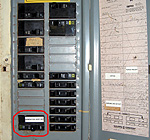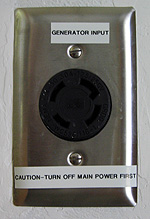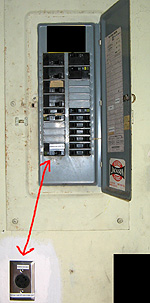 |
 Twist lock outlet, minimizes risk of accidental unplugging of gen input. I decided NOT to use my dryer or water heater outlets due to accidental unplug hazard. |
 |
AFW
Welcome To
Jason's Hurricane Preparedness Website [ Return
]
MENU: [ Hurricane Home | Wind Mitigation | Power Generation | Significant Storms ]
Supplying Generator Power To House
WARNING: DO
NOT FOLLOW WHAT IS EXPLAINED HERE
This website is intended for entertainment purposes only and not intended to
guide anyone to hooking up a generator to their home.
YOU OR OTHERS CAN BE INJURED OR KILLED.
If you wish to
hook a generator to your home,
hire a qualified experienced electrician to do
the job, then get a second opinion.
When Hurricane Charlie hit on Friday, August 13, 2004, we were without utilities for 7 solid days. I purchased a generator the day before Hurricane Charlie, and I was thankful that I did. Our Coleman 5000w/6250w surge generator (model PC0545007, see my review ) did well. I connected it directly to the circuit box (highly dangerous for you or others if you do not know exactly what you are doing!).
In April 2006, in preparation for Hurricane Season which begins June 15th, but doesn't really ramp up until August usually, I installed an additional circuit breaker (double-pole, 30 amp). Then, I installed a second male twist lock plug on the other end of my 8 gauge generator cord. To provide generator power to all of my house I do the following with takes no longer than 5 minutes:
1) Turn off the main power and lock the box (so that there is no possibility of anyone switching on the main breaker).
2) Prep the generator: Take the generator outdoors, check the oil, fuel it & start it.
3) Connect the male generator cord between the generator and the outlet under the circuit box.
4) Turn off breakers for "big ticket" appliances such as the central AC/heat, and water heater.
4) Switch on the circuit breaker in the circuit box for that outlet that the generator patch cable is connected to.
Fairly simple.
I did not purchase an expensive transfer switch, although that would be
ideal. Regarding code, it should be compliant as all I did was I added a 240v outlet on its
own breaker
(Update 4/13/06: I'm told it is NOT per code, so I will be investigating this
to make it code compliant):
 |
 Twist lock outlet, minimizes risk of accidental unplugging of gen input. I decided NOT to use my dryer or water heater outlets due to accidental unplug hazard. |
 |
Here is a picture of the cable I use to connect the gen to the house:
Here is a video of the gen supplying electric to the house:
|
Attention:
You are about to run streaming media from this web server.
Depending on the size of the streaming media, as well as your Internet
connection speed, there may be an extended wait while your computer's Windows
Media Player buffers streaming data from this web server. Be patient!
There is no need to repeatedly click the link. After you click the link
once, you should see Windows Media appear, and a progressing buffering
percentage. It is recommended
that you try to view the video under the "High Bandwidth"
category first. If you have trouble viewing it, then try the
"Low Bandwidth" option. Streaming media may be in the form of audio or video or both. If you are unable to play the streaming video, click here to download the free Windows player. |
Click here for the
high bandwidth version,
or if that doesn't work, click
here for the low bandwidth version.
I use to have to connect the bare wires of the generator cord to the lugs on the panel which is much more time consuming and potentially more dangerous (shock/electrocution risk is higher):
When my friend decided to prepare for hurricane season recently, and he wanted to purchase a generator, I decided to put together an Excel spreadsheet so that I could facilitate picking out the right generator for him. Using the spreadsheet, I am able to calculate a variety of characteristics of each generator under consideration, for comparison to one another. After careful consideration, my friend purchased a Briggs & Stratton EXL8000 (similar to this one). This baby has 8000w steady-state, 13,500w surge, electric start, and much more.
Not only can generator characteristics be normalized and compared, you can also compare them to your utility power. Using the spreadsheet, I found that running a generator will usually cost me about 5 to 6 times in terms of gasoline alone! Click here to download the spreadsheet in Microsoft Excel 95 format. As I think of new calculations, I will add them to the spreadsheet.
You will need to find out how much your appliances use at both
steady-state, also known as continuous, as well as surge. Most motor
driven devices' surge factor is somewhere from 2X-4X steady-state. That
is, if a motor draws 1000 watts in its steady-state, and it has a 2X surge
factor, then it momentarily draws 1000 X2 = 2000 watts when it starts
up. Air conditioning units have a high surge factor, from 3X to 7X I
recently read. On the spreadsheet, I plugged in what I believe to be educated
guesses at what my surge factors would be. I estimate that they would be
similar for you too.
WARNING: DO
NOT FOLLOW WHAT IS EXPLAINED HERE
This website is intended for entertainment purposes only and not intended to
guide anyone to hooking up a generator to their home.
YOU OR OTHERS CAN BE INJURED OR KILLED.
If you wish to
hook a generator to your home,
hire a qualified experienced electrician to do
the job, then get a second opinion.
Misc Links
Do It Yourself - Electrical Forum
Post: Portable Generator Gasoline Consumption Analysis
MENU: [ Hurricane Home | Wind Mitigation | Power Generation | Significant Storms ]
| Website designed by | God Bless You. |